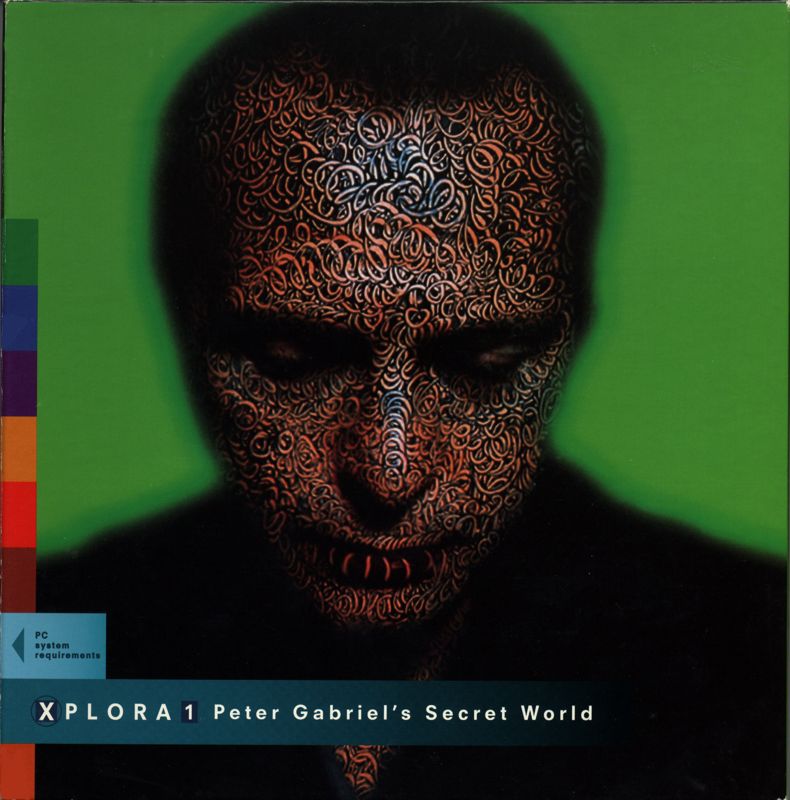Retro Replay Review
Gameplay
Xplora 1: Peter Gabriel’s Secret World unfolds as an interactive scavenger hunt, challenging players to explore various multimedia environments in search of hidden objects. Each discovery unlocks new portions of the CD, incentivizing thorough investigation and rewarding curiosity. The core mechanic revolves around sliding‐tile puzzles: by rearranging and aligning nature‐themed tiles—featuring skies, trees, and earthy landscapes—players gain access to additional rooms and content.
(HEY YOU!! We hope you enjoy! We try not to run ads. So basically, this is a very expensive hobby running this site. Please consider joining us for updates, forums, and more. Network w/ us to make some cash or friends while retro gaming, and you can win some free retro games for posting. Okay, carry on 👍)
The game’s navigation is intuitive yet deliberately paced. Rather than frantic action or complex controls, Xplora 1 encourages you to click through richly detailed panoramas, examine interactive hotspots, and piece together clues from concert backstage footage. A central mixing room allows you to experiment with song stems and ambient sounds, merging puzzle‐solving with light musical composition. This blending of gameplay and audio interactivity underscores Peter Gabriel’s artistic vision.
Challenges scale gently in difficulty. Early puzzles serve as tutorials, guiding you through sliding‐tile mechanics and hotspot investigation. As you unlock world‐instrument sections, the puzzles incorporate more visual elements—rare instruments, environmental sounds, and documentary clips—to diversify the experience. While veteran gamers may find the challenge modest, fans of music‐driven multimedia will appreciate the steady progression of discovery.
Integration between Mac and Windows 3.1 versions remains seamless. Despite its mid‐’90s origins, loading times are minimal, and navigation feels smooth even on modern emulators. Although it lacks fast‐paced action, the deliberate pacing is a feature, catering to those who savor exploration and audiovisual immersion over reflex‐based gameplay.
Graphics
The visuals in Xplora 1 are anchored by lush, nature‐inspired artwork. Rolling skies, verdant forests, and sweeping landscapes create an overarching conservation theme that ties directly into the CD’s environmental messaging. Each scene is hand‐painted and digitized, giving the game a warm, organic look that contrasts with the pixelated backdrops common in mid‐’90s titles.
Textures are crisp, with a painterly quality that suits the multimedia format. Zooming into hotspots reveals intricate details—leaf veins rustling in the breeze, distant mountain ranges fading into mist—that reward close examination. Color palettes shift subtly to match the mood of each room: cooler blues and purples in nocturnal settings, warm oranges at sunset, and deep greens in the instrument gallery.
Video segments, such as concert backstage footage and interviews, have been carefully compressed to maintain clarity without overwhelming CD‐ROM bandwidth. While the frame rate dips occasionally, the archival quality of these clips preserves the intimacy of behind‐the‐scenes moments. The mixing room’s animated faders and waveforms are both functional and visually appealing, offering graceful transitions as you layer audio tracks.
Even on period hardware, Xplora 1’s graphic fidelity holds up. The decision to favor stylized art over photorealism ensures that screen tearing and aliasing remain minimal. For retro gaming enthusiasts or newcomers curious about multimedia history, these visuals deliver a charming, immersive aesthetic.
Story
Though Xplora 1 isn’t a narrative‐driven adventure in the traditional sense, it weaves a cohesive thematic arc centered on discovery and conservation. The “secret world” motif manifests as you gradually piece together fragments of Peter Gabriel’s creative process—song snippets, video diaries, and musings on nature’s fragility. Each unlocked section reads like a chapter in an unfolding documentary.
The scavenger hunt theme lends a playful impetus to exploration. Rather than following a linear storyline, you chart your own path, uncovering hidden vaults of audio samples and instrumental showcases. This nonlinear structure mirrors the creative journey, reflecting how artists experiment, discard, and refine ideas before achieving a final work.
Interludes of backstage footage introduce real‐world context, offering glimpses into tour life, rehearsal sessions, and candid interviews. These segments humanize Gabriel’s persona, framing the puzzles and musical explorations not just as game objectives but as fragments of a larger artistic statement. The conservation theme emerges subtly through environmental imagery and commentary on world instruments, urging players to value cultural and ecological diversity alike.
While there’s no central antagonist or dramatic climax, the satisfaction of unlocking every room culminates in a sense of completion. By the final puzzle, you’ve not only navigated an intricate multimedia collage but also absorbed a cohesive message about creativity, ecology, and global musical heritage.
Overall Experience
Xplora 1: Peter Gabriel’s Secret World stands out as an innovative fusion of music, art, and interactive design. It eschews conventional gameplay tropes in favor of a contemplative, exploratory approach that aligns perfectly with Gabriel’s reputation as a boundary‐pushing musician. For fans of experimental multimedia and puzzle aficionados alike, the experience feels both nostalgic and refreshingly original.
The soundtrack is a highlight, featuring stem tracks and environmental audio that you can remix in the mixing room. Unlocking world instruments invites you to sample exotic sounds—from African balafons to South American flutes—enhancing replay value as you revisit puzzles to hear new musical layers. The audio fidelity remains impressive given the CD‐ROM era constraints, lending the game a timeless quality.
Despite its age, Xplora 1 runs smoothly on modern emulation setups and offers a user-friendly interface. The lack of action‐oriented challenges may deter players seeking adrenaline‐pumping thrills, but the deliberate pacing rewards those who prefer reflection, creativity, and cultural exploration. The conservation message is delivered with subtlety, never feeling preachy yet consistently present.
Overall, Xplora 1 delivers an eclectic, engaging journey into Peter Gabriel’s creative universe. It’s a must-try for music enthusiasts, retro gamers, and anyone curious about the intersections of art and interactivity. The game’s charm and educational value ensure that its “secret world” remains an inspiring destination, even decades after its original release.
 Retro Replay Retro Replay gaming reviews, news, emulation, geek stuff and more!
Retro Replay Retro Replay gaming reviews, news, emulation, geek stuff and more!




Reviews
There are no reviews yet.